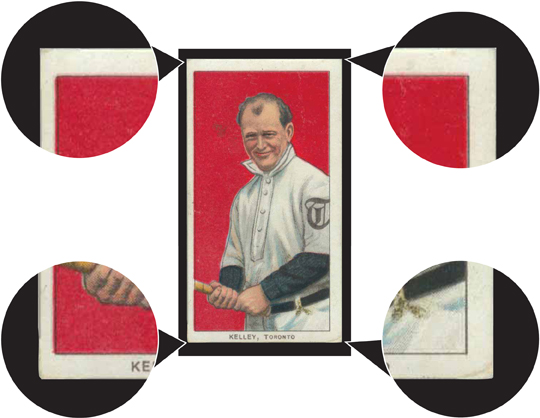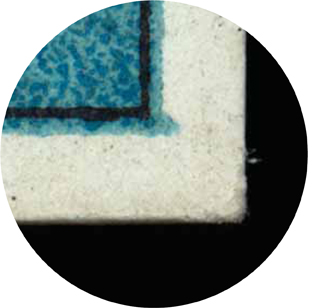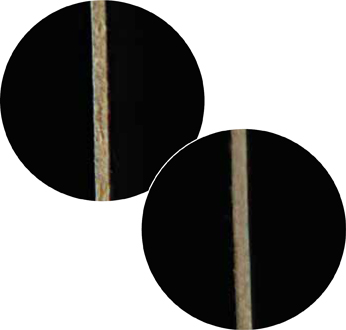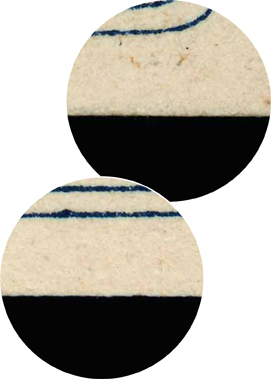
Ways to Detect Trimming in T206 cards
Recently, many collectors of SGC cards have expressed a great deal of concern dealing with the topic of card alterations. There is a tremendous amount of misinformation, inaccurate information and incomplete information being disseminated on this topic. By far, the most prevalent and difficult to detect type of alteration is trimming. To the best of my knowledge, this is the first in-depth article on this topic.
The article will be somewhat technical, and will provide you with some illustrations that will be very useful. Due to the complexity and subtleties involved in this procedure, however, I can only deal with one card set at a time. Therefore I have chosen to focus first on the set that is most popular and prevalent among SGC collectors – T206. The purpose of this article is to give our clients some of the knowledge necessary to help detect trimmed T206 cards.
Often times, collectors believe that detecting a trimmed card is a easy as pulling out a ruler and making sure the card measures to the Standard Catalog’s published measurement of 2 5/8” by 1 1/2”. Nothing is further from the truth; the bottom line is that T206s can vary dramatically in size. They can easily be a full 32nd of an inch short lengthwise and a full 16th of can inch narrow. On the flip side, they can be as much as a 16th of an inch oversized in either direction.
There are some fairly simple ways to tell if cards in general have been trimmed. My first piece of advice is to really take a good look at your card. Study the edges. There are certain techniques that can be used universally in detecting card trimming. First, check to see if the cut of the card is wavy - wavy edges are common traits for trimmed cards. The easiest way to tell if an edge is wavy is to hold the card at eye level, perpendicular to the ground. Run your eye across the edge that you suspect is trimmed. Cards were generally not cut with wavy edges, so a wavy edge is a bad sign.
However, wavy edges are not in themselves proof that a card is trimmed. A second technique in determining card trimming is checking for uneven corner wear. Common sense would tell you that a card should have (but does not necessarily have to have) even corner wear. When the wear on a card is not even, that is an indicator that the card has been trimmed. For example, if you have a T206 where the top two corners are Near Mint corners, and the bottom two corners are excellent corners there is a strong possibility that the top edge has been trimmed. Ask yourself, how or why would the card have survived in that state?
A third technique is looking for edges that are not parallel - “the equal and opposite test.” A card’s borders should be equal and opposite in size and centering. By that, I mean that the card’s size measurements should be consistent along an edge and the cards centering should also be consistent. By the measurement being consistent, I mean that the left side of the card should have the same dimensions as the right side of the card and vice versa. The centering of the card should be “equal and opposite.” This essentially means that the total border on the right side of the card should be equal to the total border on the left side of the card.
Another helpful technique is looking at the toning of the grain on the 4 borders of the card. Grain that is not uniform in toning is uncommon for cards and can be an indicator of card trimming. These three techniques are helpful but are not the final determining factor in telling whether a card has been trimmed. Each card issue has some very subtle edge characteristics that are unique to that issue. The SGC graders have studied these characteristics rigorously. It is the presence, or absence, of the subtle characteristics that will ultimately determine whether or not SGC will encapsulate a card or whether the card will be returned for evidence of trimming.
As stated earlier, I will discuss T206s in this article. T206s might be the most commonly trimmed pre WWII issue. It is common knowledge that thousands of these cards were trimmed in the 70s and 80s for no other reason that to improve the aesthetics of the card. Many of the cards had extremely large borders oversized borders which made it easy for them to be trimmed.
Each edge of a T206 has distinct characteristics. The presence or absence of certain characteristics is the best indicators in detecting card trimming.
On the front of a T206, the top border of the card virtually always has a slight etching, appearing to be the top of a “roll” running across the card. This is present due to how the cards were cut at the factories. Oddly enough, even though these cards were printed in many different factories, they were all printed and cut very similarly, with the exception of American Beauties. American Beauties are much more narrow than the average T206.
The aforementioned roll can be difficult to spot without magnification. The “roll” should be seen on one of the side edges as well as the top or bottom edge. If this roll or etching is not present on the top edge and either the left or right edge, there is an excellent chance your card has been trimmed.
Possibly the most important factor in detecting evidence of trimming on a T206 is examining the grain of the card’s edge. The grain should essentially be flat with no “graininess” or fluffiness to it. Upon close inspection, very faint “striations” might be present. Striations can best be described as faint diagonal lines. “Fluffy” grain is the type of grain commonly seen on Topps cards from the 1950’s. “Fluffy” grain can have a rough look to it and tiny holes might be seen in the edge.
The reverse of the card should be examined as closely as the front of the card. Many times, it is easier to detect evidence of trimming by examining the reverse of a card. On T206s, there is, more often than not, slight chipping present along the perimeter of the card. When a card has been trimmed, the chipping disappears.
In conclusion, T206s are possibly the most commonly trimmed pre WWII issue. Remember the most common misconception regarding trimming is that the size of the card is the determining factor in detecting card trimming. The easiest way to detect card trimming is to study the grain of the card’s edge. On T206s the “fluffy” grain is what to look for. Although it is not the only determining factor, it is the quickest and easiest way to detect trimming on the issue. Trimming is difficult to catch, but if you take the time to study the issue and carefully examine the card, it is a piece of cake.
The article will be somewhat technical, and will provide you with some illustrations that will be very useful. Due to the complexity and subtleties involved in this procedure, however, I can only deal with one card set at a time. Therefore I have chosen to focus first on the set that is most popular and prevalent among SGC collectors – T206. The purpose of this article is to give our clients some of the knowledge necessary to help detect trimmed T206 cards.
Often times, collectors believe that detecting a trimmed card is a easy as pulling out a ruler and making sure the card measures to the Standard Catalog’s published measurement of 2 5/8” by 1 1/2”. Nothing is further from the truth; the bottom line is that T206s can vary dramatically in size. They can easily be a full 32nd of an inch short lengthwise and a full 16th of can inch narrow. On the flip side, they can be as much as a 16th of an inch oversized in either direction.
There are some fairly simple ways to tell if cards in general have been trimmed. My first piece of advice is to really take a good look at your card. Study the edges. There are certain techniques that can be used universally in detecting card trimming. First, check to see if the cut of the card is wavy - wavy edges are common traits for trimmed cards. The easiest way to tell if an edge is wavy is to hold the card at eye level, perpendicular to the ground. Run your eye across the edge that you suspect is trimmed. Cards were generally not cut with wavy edges, so a wavy edge is a bad sign.
However, wavy edges are not in themselves proof that a card is trimmed. A second technique in determining card trimming is checking for uneven corner wear. Common sense would tell you that a card should have (but does not necessarily have to have) even corner wear. When the wear on a card is not even, that is an indicator that the card has been trimmed. For example, if you have a T206 where the top two corners are Near Mint corners, and the bottom two corners are excellent corners there is a strong possibility that the top edge has been trimmed. Ask yourself, how or why would the card have survived in that state?
A third technique is looking for edges that are not parallel - “the equal and opposite test.” A card’s borders should be equal and opposite in size and centering. By that, I mean that the card’s size measurements should be consistent along an edge and the cards centering should also be consistent. By the measurement being consistent, I mean that the left side of the card should have the same dimensions as the right side of the card and vice versa. The centering of the card should be “equal and opposite.” This essentially means that the total border on the right side of the card should be equal to the total border on the left side of the card.
Another helpful technique is looking at the toning of the grain on the 4 borders of the card. Grain that is not uniform in toning is uncommon for cards and can be an indicator of card trimming. These three techniques are helpful but are not the final determining factor in telling whether a card has been trimmed. Each card issue has some very subtle edge characteristics that are unique to that issue. The SGC graders have studied these characteristics rigorously. It is the presence, or absence, of the subtle characteristics that will ultimately determine whether or not SGC will encapsulate a card or whether the card will be returned for evidence of trimming.
As stated earlier, I will discuss T206s in this article. T206s might be the most commonly trimmed pre WWII issue. It is common knowledge that thousands of these cards were trimmed in the 70s and 80s for no other reason that to improve the aesthetics of the card. Many of the cards had extremely large borders oversized borders which made it easy for them to be trimmed.
Each edge of a T206 has distinct characteristics. The presence or absence of certain characteristics is the best indicators in detecting card trimming.
On the front of a T206, the top border of the card virtually always has a slight etching, appearing to be the top of a “roll” running across the card. This is present due to how the cards were cut at the factories. Oddly enough, even though these cards were printed in many different factories, they were all printed and cut very similarly, with the exception of American Beauties. American Beauties are much more narrow than the average T206.
The aforementioned roll can be difficult to spot without magnification. The “roll” should be seen on one of the side edges as well as the top or bottom edge. If this roll or etching is not present on the top edge and either the left or right edge, there is an excellent chance your card has been trimmed.
Possibly the most important factor in detecting evidence of trimming on a T206 is examining the grain of the card’s edge. The grain should essentially be flat with no “graininess” or fluffiness to it. Upon close inspection, very faint “striations” might be present. Striations can best be described as faint diagonal lines. “Fluffy” grain is the type of grain commonly seen on Topps cards from the 1950’s. “Fluffy” grain can have a rough look to it and tiny holes might be seen in the edge.
The reverse of the card should be examined as closely as the front of the card. Many times, it is easier to detect evidence of trimming by examining the reverse of a card. On T206s, there is, more often than not, slight chipping present along the perimeter of the card. When a card has been trimmed, the chipping disappears.
In conclusion, T206s are possibly the most commonly trimmed pre WWII issue. Remember the most common misconception regarding trimming is that the size of the card is the determining factor in detecting card trimming. The easiest way to detect card trimming is to study the grain of the card’s edge. On T206s the “fluffy” grain is what to look for. Although it is not the only determining factor, it is the quickest and easiest way to detect trimming on the issue. Trimming is difficult to catch, but if you take the time to study the issue and carefully examine the card, it is a piece of cake.

An example of uneven corner wear on a trimmed T206. In this case, the top two corners exhibit NMT characteristics, while the bottom two corners are VG-EX to EX. The top edge of the card has been trimmed. Less visible in this photo is the wavy top edge of the card — wavy edges are also an indicator of trimming.

An example of the “roll” cut present on two sides of a naturally-cut T206. In this picture, you can see that the bottom edge of the card appears to “roll” — you can see the depth of the cut as it appears to slope toward the edge. In contrast, there is no “roll on the cards’s right edge.

The image on the top is a trimmed T206 under magnification. You can see the edge has a rough look with tiny holes — “nooks and crannies” — in the edge. The image directly at right is an untrimmed T206 under magnification — the edge is very smooth, with faint diagonal “striations.”

The image on the top is the back of an untrimmed T206 under magnification. You can see light chipping along the edge. The image on the bottom shows the back of a trimmed T206 — note the lack of chipping.
